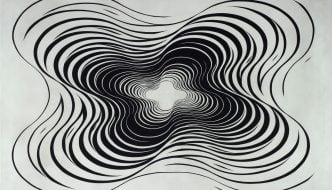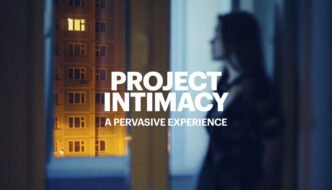Review: The Musical Museum
December 9, 2015

The Folk Forest by James Green
Sheffield Graves Gallery teamed up with The Folk Forest to create a ‘Musical Museum’. TSOTA’s Samantha Williams went along to experience the acoustic and atmospheric evening.
In the early 1990’s Rirkrit Tiravanija turned a New York gallery into a space that encouraged social interaction through a shared meal. The make-shift kitchen and the act of the artist serving Thai curry to guests subverted an environment where a visitor would usually expect to be surrounded by quiet contemplation.
Like in many of his works, Tiravanija invited guests to enter into the gallery space – eat, relax, and talk freely, with the emphasis on the space as a place of social intervention. Over 20 years later this experimentation with gallery space as a platform for ‘models of sociability’ (Nicholas Bourriaud, Relational Aesthetics) continues, and curators are still seeking new and exciting ways of ‘re-imagining the gallery experience’. Which, funnily enough, is the ethos behind ‘Musical Museum’ which I attended at the Graves Gallery last week.
 Entering the shop/foyer area, you could hear a hum of activity, an exciting prospect in a usually quiet environment. Now, for those of you unfamiliar with the lay-out of the Graves Gallery, when you enter the top floor of Sheffield City Library you have the option to go either right or left, moving through a series of rooms separated by large doors in either clockwise or anti-clockwise direction, and finally returning back to where you started; a perfect layout for allowing several acts to perform simultaneously without interference.
Entering the shop/foyer area, you could hear a hum of activity, an exciting prospect in a usually quiet environment. Now, for those of you unfamiliar with the lay-out of the Graves Gallery, when you enter the top floor of Sheffield City Library you have the option to go either right or left, moving through a series of rooms separated by large doors in either clockwise or anti-clockwise direction, and finally returning back to where you started; a perfect layout for allowing several acts to perform simultaneously without interference.
I chose to go through the door to the right, where, set amongst the multitude of historic portraits, Pete David & Landon Shaffer of The Payroll Union were singing the tail of Abigail Williams, a significant figure in the Salem Witch Trials. The slow, melancholic tone of the song, combined with the piercing glares of the portraits made for a feeling that while disconcerting was also very hypnotic.
Moving through the galleries, the next band we came across was Bellevue Gypsy Jazz Band, whom I definitely feel had the hardest job of the evening. Set in the ‘Dusk till Dawn’ space of Gallery V, the band looked a little underwhelming in such a large and brightly lit area. While the ensemble looked impressive enough, the set up lacked the intimacy that the other rooms provided, which I think was the main contributor to the bands significantly smaller audience.

Graves Art Gallery
Next, moving into Graves contemporary space, Nuala Hunan’s soft but powerful voice filled the room. While definitely my favourite act of the evening based purely on the spine-tingly tone of her music, I did feel that Nuala’s sound did not fit so well with the context of the room. Her music was the most modern in style so I see why it was selected for that space, but it felt too soft when placed next to the more radical pieces of art that the Graves displays. I also felt that her position in the room, and the single focus lighting created an environment in which she was a musician playing on an interesting stage, as opposed to the guests having the opportunity to view the art in a new way – through the addition of music.
The last act I saw that evening was instrumental guitarist Toby Fay, lit up in a deep red and set against a painting of a stormy sea. His compositions complimented the context behind the imagery in Gallery VIII ‘A Golden Age’. The flow of the music told a story in just as much detail as the paintings surrounding him, the lack of lyrics allowed the viewer to use their imagination. This combination created a synchronicity which I felt achieved that idea of ‘re-imagining the gallery experience’, without allowing the spectacle of the musical acts to overshadow the art.
Now the blurring of the lines between music and art is no new concept, but I have to say this is the first time I have experienced a live music set within a traditional museum gallery space. Experiences I have had previously proposed the musical pieces to be ‘works of art’ in their own right, as opposed to The Folk Forest using Graves Gallery and its displayed works as an interesting stage for the musicians performing.
Perhaps I have been overly critical, and don’t get me wrong – I’ll champion anything that gets the public more engaged in the arts, however I feel that it’s important that a balance is created between the music and the art. The thing that you are trying to highlight or ‘re-imagine’ should not become secondary to the tool used to highlight it, that being said, the music should be equally as important. The curators should seek to create a culture in which the audience do not stand with their backs to the art looking to the musician, but view both art work and musician, experiencing and contemplating, both visually and audibly at once.
Overall, I have to say the event was extremely enjoyable. It really was a new experience and definitely changed the gallery environment. I particularly liked the act of sitting down on the gallery floor, mainly because it would be considered such a faux pas in many galleries across the world. My only regret of the night is that I was not there long enough to catch all of the acts. Fingers crossed I’ll be able to make it to Folk Forest’s next event (see link below) ‘Christmas with the Folk Forest’.
More info on the Museums Sheffield website.




Comments